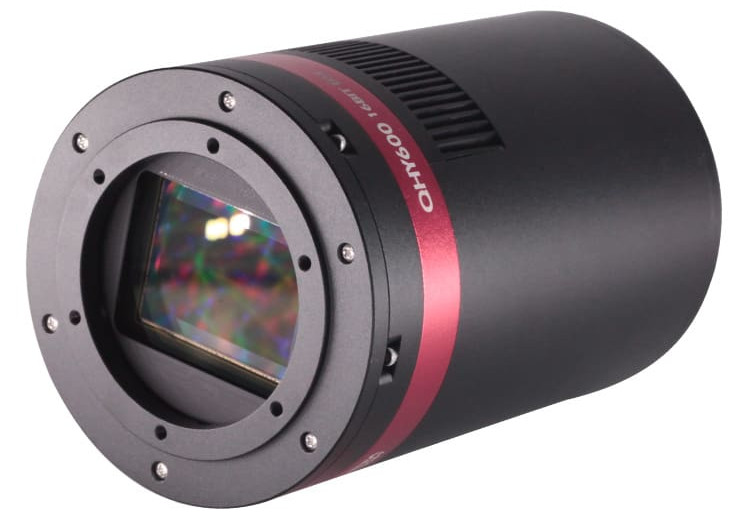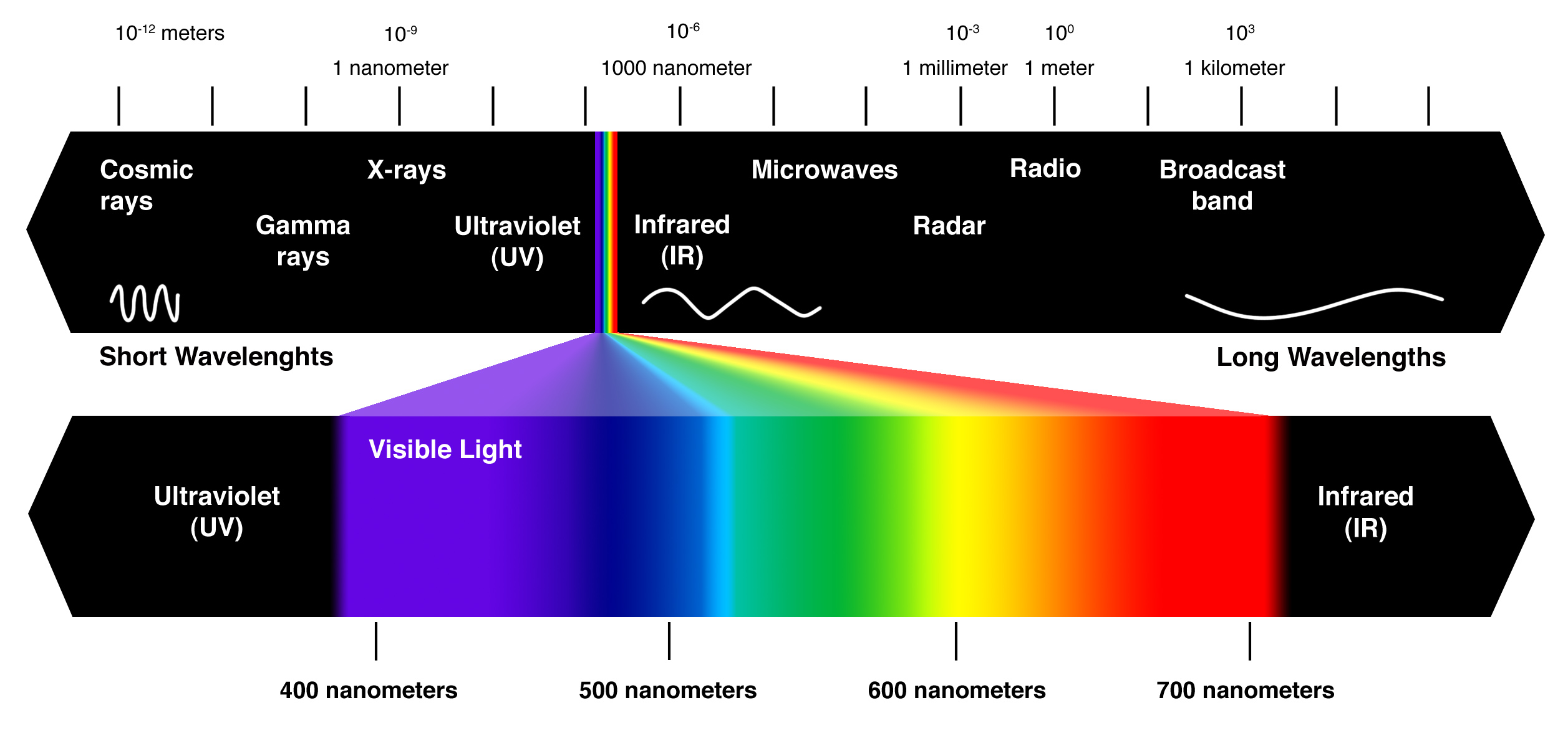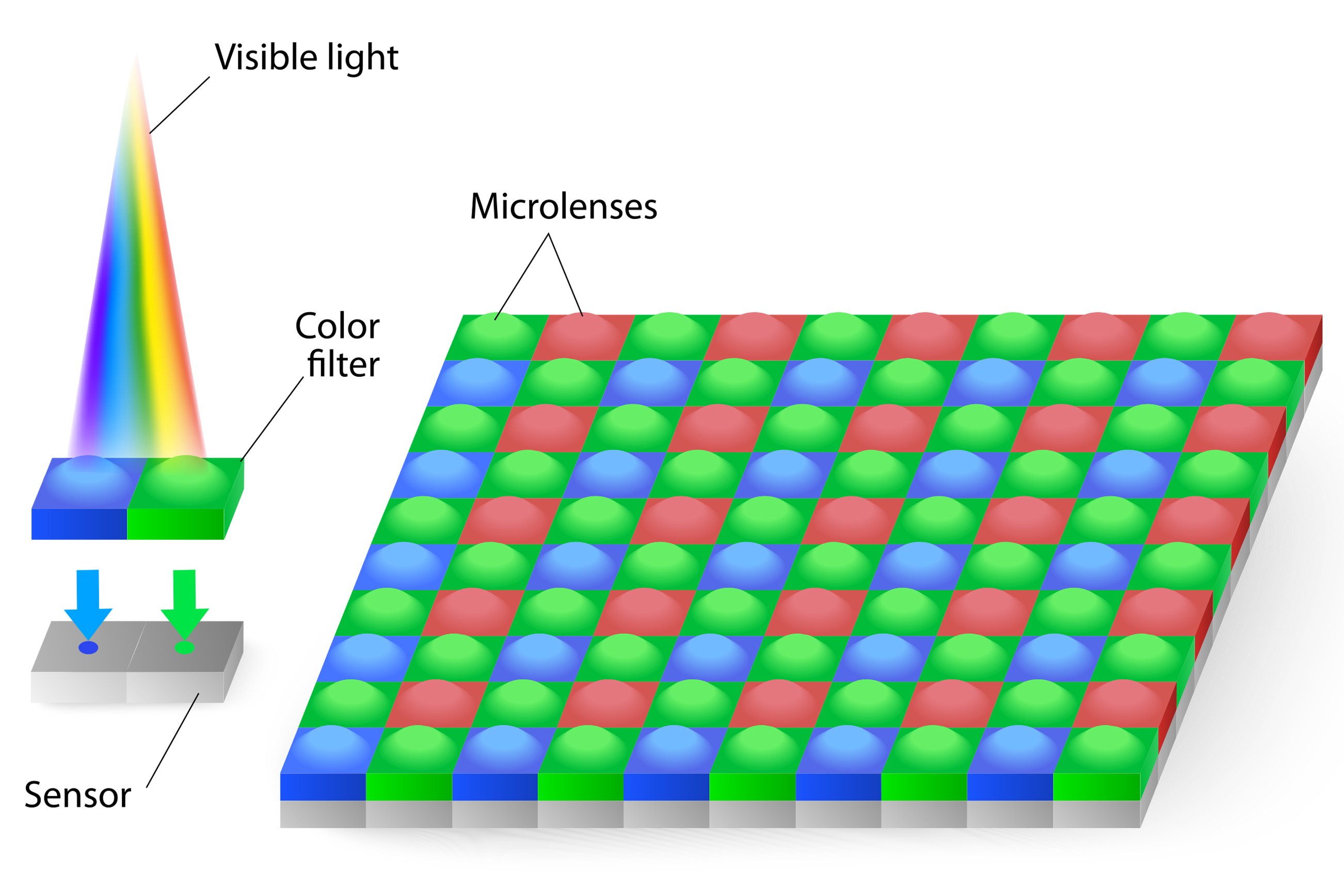Sensors
What people documenting cultural heritage should know when comparing sensors used for multispectral imaging
Multispectral Imaging Capture Equipment Rodeo
Rochester, New York, June 27, 2025
Todd Hanneken, St. Mary’s University
Overview
Sensors quantify the amount of light coming through the lens with varying degrees of spatial resolution and noise

Major Types of Sensors
- Multispectral sensors vs. sensors intended to approximate the human visual system
- Full-spectrum vs. visible spectrum
- Monochrome (panchromatic) vs. color
Major Types of Sensors
- Multispectral sensors vs. sensors intended to approximate the human visual system
- Silicon is receptive to wavelengths 200-1100 nanometers (less so at extremes, lenses also limit short wavelengths), humans perceive wavelengths 400-700 nanometers
- Silicon itself does not distinguish wavelength (without controlled lighting and filters), humans have three color receptors
- Multispectral imaging seeks to go beyond the range and/or color resolution of the human eye
- Full-spectrum vs. visible spectrum
- Monochrome (panchromatic) vs. color

Major Types of Sensors
- Multispectral sensors vs. sensors intended to approximate the human visual system
- Full-spectrum vs. visible spectrum
- Cameras marketed for astrophotography, machine vision, etc. do not limit the sensitivity of silicon to the human visual range
- Cameras marketed for color photography use filters to block infrared (IR)
- Relatively easy to remove the IR block filter
- Monochrome (panchromatic) vs. color

Major Types of Sensors
- Multispectral sensors vs. sensors intended to approximate the human visual system
- Full-spectrum vs. visible spectrum
- Monochrome (panchromatic) vs. color
- Silicon counts photons, does not measure wavelength
- Panchromatic in the sense of measuring all the wavelengths
- Monochromatic in the visualization of all intensities as a shade of gray
- Digital color cameras mostly use a Bayer mosaic to divide the pixels into pixels dedicated to red, green, and blue

Options for using sensors with Bayer mosaics for MSI
- Embrace the fact that you are getting three filters for free in one shot, accept reduced spatial resolution
- Use only the green channel
- Interpolate
- Removing the Bayer filter is difficult, expensive, and never truly equivalent to panchromatic
- A different question is how well the three micro-filters approximate human color perception.
Sensors We Tested by Type
- Full-spectrum panchromatic: QHY 411 ($50,000), QHY 600 ($4000), Pixelink ($1245), Flir Blackfly ($700), QHY miniCam ($500)
- Full-spectrum with Bayer mosaic: Kolari RP ($2000), Spencer R7, Kolari Elph ($350)
- Consumer color cameras: cell phones, some tests of Canon T1i
Sensor Size and Resolution
- Sensor size is the physical size of the sensor (measured in millimeters) or the size of a single pixel (measured in micrometers)
- Spatial resolution is the number of pixels measured (measured in megapixels), linked to pixels per inch
- Analogous to the size of a pizza vs. the number of slices into which it is cut
Sensor Size
- Bigger is better in that a sensor twice as large will capture twice as much light
- Bigger is more expensive for the silicon, the camera, and especially for the lens to focus more light at comparable depth of field and chromatic aberration
Sensors We Tested by Size
- Medium format (54x40mm): Sony IMX 411 in the QHY 411 Pro ($50,000)
- Full frame (35x24mm): Sony IMX 455 in the QHY 600 ($4000), Kolari RP ($2000)
- APS-C (22x15mm): Spencer’s R7, Canon T1i
- 1" type (13x9mm): Sony IMX 183 in the Flir Blackfly and Pixelink ($700-1200)
- 1/1.2" type (11x8mm): Sony IMX 585 in the QHY Minicam ($500)
- 1/1.31" type (9.6x7.2mm): Google Pixel 6
Sensor Spatial Resolution
- 150 megapixels = 14192 × 10640 = 24" x 18" at 600 PPI (QHY 411, $50,000)
- 62 megapixels = 9600 x 6422 = 16" x 11" (QHY 600, $3900)
- 20 megapixels = 5472 x 3648 = 9" x 6" (Flir Blackfly IMX 183, $700)
- 12 megapixels = 4032 x 3024 = 7" x 5" (Pixel 6 processed)
- 8 megapixels = 3856 x 2180 = 6" x 4" (QHY mini, $500)
- Workarounds: tiling, stitching, lower PPI
Noise
- Can appear as salt-and-pepper or lines
- Consistent noise can be corrected through dark subtraction
- Inconsistent noise, even if minor in one image, amplifies when multiple images are processed for enhancements or accurate color
- Software “denoise” functions are not magic, effectively blur the image and reduce spatial resolution
- Can be caused by thermal energy, addressed by thermoelectric cooling
Sensors We Tested with Thermoelectric (Peltier) Cooling
- QHY 411 ($50,000), QHY 600 ($4000), QHY miniCam ($500)
- Rated for cooling to 30-45° Celsius below ambient temperature
- Tests used -10° Celsius (14° Fahrenheit)
How We Measured Noise
- Dark noise: how much inconsistency comes from the sensor when there is no light at all?
- White noise: how much inconsistency comes from the sensor as it reads light?
Noise Results
- QHY 411 ($50,000) TBA, TBA
- QHY 600 ($4000) TBA, TBA
- Kolari RP ($2000) TBA, TBA
- Spencer R7 TBA, TBA
- Pixelink ($1245) TBA, TBA
- Flir Blackfly ($700) TBA, TBA
- QHY miniCam ($500) TBA, TBA
- Kolari Elph ($350) TBA, TBA
Settings
- Exposure time, time value (Tv)
- Gain, ISO
- Offset
- Bits per pixel
Questions?
Slides and speaker notes available online at https://palimpsest.stmarytx.edu/rodeo/2025/sensors.html
